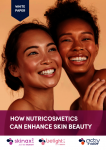Green tea supplements may benefit skin from within

Skin levels of green tea catechin compounds increased following oral supplementation for 12 weeks, and these increased levels were associated with significantly lower levels of inflammatory markers when skin was exposed to UV radiation, according to findings published in the British Journal of Nutrition.
“Our data provide the first evidence that green tea catechins can be taken up into the skin following oral intake in human subjects and indicate their complex skin incorporation pattern,” wrote researchers from the Universities of Manchester, Bradford, and Leeds.
“Significant reduction was found in the cutaneous UVR erythema dose–response, with greatest effect at higher doses, and this reduced inflammation may be attributable to the associated significant abrogation of UVR up-regulation of the potent pro-inflammatory 12-LOX metabolite, 12-HETE.”
Tea benefits
The study adds to the list of potential health benefits of green tea and the compounds it contains.
The majority of science on tea has looked at green tea, with benefits reported for reducing the risk of Alzheimer's and certain cancers, improving cardiovascular and oral health, and helping with weight management.
Green tea contains between 30 and 40% of water-extractable polyphenols, while black tea (green tea that has been oxidized by fermentation) contains between 3 and 10%. Oolong tea is semi-fermented tea and is somewhere between green and black tea. The four primary polyphenols found in fresh tealeaves are epigallocatechin gallate (EGCG), epigallocatechin (EGC), epicatechin gallate (ECG), and epicatechin (EC).
Study details
Led by The University of Manchester’s Lesley Rhodes, the researchers recruited 14 healthy human subjects (average age of 42.5, 12 women) with fair skin (phototype I/II) and gave them low-dose green tea catechin supplements at a daily dose of 540 mg in combination with a daily vitamin C dose of 50 mg for 12 weeks. The supplements were provided by Nestec Limited.
“Since one large cup of green tea (250 ml) contains approximately 300 mg of catechins (EC, ECG, EGC and EGCG), then the modest level of green tea catechins intake in the present study, i.e. approximately 540 mg, is seen to be readily achievable in daily life, and this is already consumed in many parts of the world,” they explained.
The effects of the supplements were tested before and after supplementation by exposing buttock skin to UVR and quantifying the level of sunburn (erythema).
Results showed that levels of metabolites of green tea catechins increased in skin fluids after supplementation.
In addition, erythema levels were reduced after the 12 week supplementation period, added Rhodes and her co-workers.
The markers of inflammation, PGE2 and 12-HETE, were both found to be increased by UV exposure, but the 12-HETE levels were reduced by the supplements. No effect on PGE2 was observed.
“Thus, green tea catechin intake results in the incorporation of catechin metabolites into human skin associated with abrogated UVR-induced 12-HETE; this may contribute to protection against sunburn inflammation and potentially longer-term UVR-mediated damage,” wrote the researchers.
“Manipulation of pro-inflammatory signaling pathways through supplementation with nutritional bioactives is an attractive strategy for photoprotection in human subjects and may represent a complementary approach to topical sunscreens, which are infrequently and generally poorly applied.”
Source: British Journal of Nutrition
Published online ahead of print, FirstView Articles, doi: 10.1017/S0007114512006071
“Oral green tea catechin metabolites are incorporated into human skin and protect against UV radiation-induced cutaneous inflammation in association with reduced production of pro-inflammatory eicosanoid 12-hydroxyeicosatetraenoic acid”
Authors: L.E. Rhodes, G. Darby, K.A. Massey, K.A. Clarke, T.P. Dew, M.D. Farrar, S. Bennett, R.E.B. Watson, G. Williamson, A. Nicolaou










